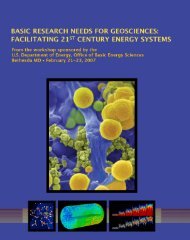Measurement Science Roadmap for Net-Zero Energy Buildings
Measurement Science Roadmap for Net-Zero Energy Buildings
Measurement Science Roadmap for Net-Zero Energy Buildings
- No tags were found...
Create successful ePaper yourself
Turn your PDF publications into a flip-book with our unique Google optimized e-Paper software.
III. ONSITE ENERGY PRODUCTIONAlternative energy systems can be used to produce electricity and thermal energyat the building’s site, eliminating transmission and distribution losses.Enhancements to building efficiency and the use of advanced technologies areexpected to yield a 70% improvement in today’s building energy profile;renewable energy systems are expected to provide the remaining 30 % to achievenet-zero energy. The nature of the technology used will depend on the electricaland thermal demands associated with the building, building design, access toalternative energy sources, and other site-specific factors.This topic area focuses on the technologies and measurement science needsrelated to the use of alternative⎯including renewable⎯energy systems incommercial and residential buildings. The scope encompasses solar (e.g.,photovoltaics, including building integrated and both active and passive solarthermal technologies as well as combined photovoltaic and thermal systems);wind (e.g., wall- or roof-integrated, stand-alone); onsite hydropower; combinedheat and power systems; and, building integration and grid interconnectivity ofthese systems.A. Characteristics of the Future Built EnvironmentThe potential future attributes of onsite power generation technologies aresummarized in Table III-1. In the future, buildings are likely to becomeintegrated generation units, utilizing renewable energy technologies andcombined heat and power (CHP) systems to become active participants inutilities’ energy management activities. Ultimately, buildings would ideallybecome entirely self-sufficient entities, with dedicated central power generationfacilities providing a minimal amount of additional electricity.<strong>Energy</strong> ProductionTable III‐1. Onsite <strong>Energy</strong> Production – Future Built Environment• <strong>Energy</strong> systems are transparent in aesthetics and operation• Characteristics:- <strong>Net</strong> positive power output from buildings to be dispatched- Aggressive conversion efficiencies- Dispatch‐able loads- Low or no carbon emissions- Integrated systems to include power requirements <strong>for</strong> electric hybrid or electric vehicles• All natural resources available on the site to fully operate the building are utilized (not just solar, butalso wind, geothermal, etc.)• Lower cost photovoltaics (PV); applications beyond roof tops• PV systems are fully integrated into building materials• Cost‐effective solar desiccant cooling6 <strong>Measurement</strong> <strong>Science</strong> <strong>for</strong> <strong>Net</strong>-<strong>Zero</strong> <strong>Energy</strong> <strong>Buildings</strong>
















